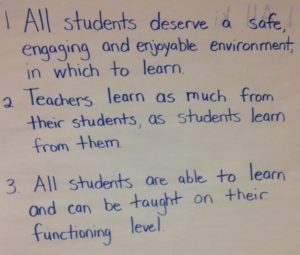Building Staff Community Early in the Year
Emily lay curled up under her covers long after the alarm clock had woken her up. Her mother came into her room. “Emily! You need to get up! It’s the first day of school and it’s time to get going!”
Emily put the pillow over her head. “I’m scared! What if the kids are mean to me? What of the teachers don’t like me? What if I don’t know what to do?!”
Her mother sighed and smiled knowingly. “I know the first day is tough, and we go through this every year. I’m sure everything will be fine. Besides, you have to go to school on the first day—you’re the principal!”
You’ve probably heard this classic beginning-of-the-school-year joke before, but it serves as a nice reminder. The beginning of the year is both exciting and stressful for everyone: students, parents, teachers, and administrators! With so much to do and so much pressure to accomplish everything right now, it’s important to remember that the beginning of the year should be about building relationships and forming communities that can work well together.
In a recent post for teachers, I share some strategies for getting to know students. In this post, I’d like to focus on a few ideas for administrators. How can principals and school leaders both get to know their staff and help their staff know each other? After all, administrators are also working to create positive and collaborative learning communities—staff who can work together and learn together effectively throughout the year. And, just like teachers should blend community-building activities into daily academic teaching, so too, school leaders can help staff get to know each other through the work they do together as a staff.
So, with that in mind, here are a few activities school leaders could use in staff meetings early in the year to help staff reconnect and build more positive working relationships.
Blend Social and Academic Sharing: As a part of staff discussions at the beginning of the year, you may have teachers turn and talk to share ideas. As you do this, sprinkle in some connected social topics. For example, as staff begin to examine standards-based assessment strategies, you might give three short discussion topics: 1. What are some of your memories of grading and assessment from when you were a student? What are some of your experiences with grades as a parent/aunt/uncle/friend? 3. What are some questions you have about standards-based grading? Or, if teachers are about to discuss strategies for reading instruction, begin by having teachers reflect on books they read over the summer or some of their favorite authors.
Use Active and Interactive Protocols for Group Discussions: Just like students, our adult learners will be more engaged and socially connected when we use structured and interesting protocols to guide their group work. Many resources about facilitating effective PLCs have great suggestions. Two resources that I love, which are packed with effective protocols are Teacher Teams that Get Results and Energize Your Meetings!
 Generate Shared Philosophical Statements: So often in schools, we’re so busy engaged in what to do, we neglect to pause and remember why we do. Creating shared philosophical statements (like the one pictured, from a recent workshop I taught in Virginia) can help teachers reconnect with their sense of mission and purpose. It can also help bring staff together and highlight shared values. Here’s a process to try:
Generate Shared Philosophical Statements: So often in schools, we’re so busy engaged in what to do, we neglect to pause and remember why we do. Creating shared philosophical statements (like the one pictured, from a recent workshop I taught in Virginia) can help teachers reconnect with their sense of mission and purpose. It can also help bring staff together and highlight shared values. Here’s a process to try:
- Place teachers together in groups, perhaps by grade level, team, or department. Or, you might consider mixing teachers together who don’t often connect. Decide which will be a best fit for your staff.
- Let them know that their challenge will be to create a few positive belief statements about students and learning with which they all agree.
- Give a few examples to get them started. Make sure these statements are positive! For example, one of my favorites is “All students want to learn.” Another great one, voiced so eloquently by Ross Greene, is “Kids do well when they can.”
- Have teachers spend a few minutes writing and reflecting silently and alone to generate some of their own positive beliefs about students and learning.
- In groups, have teachers share their beliefs and look for common threads.
- Together, have groups create belief statements they all share. They should write these statements on chart paper.
- Post the charts and have all staff read and reflect on their shared beliefs.
- Consider holding onto these charts. Come back to them periodically throughout the year.
These are just a few ways to help build connections with and between staff. If you’re interested in more ideas for how to begin the school year off in a positive way, you might consider checking out a webinar I taught: The First Weeks of School: Best Practices for Principals.




